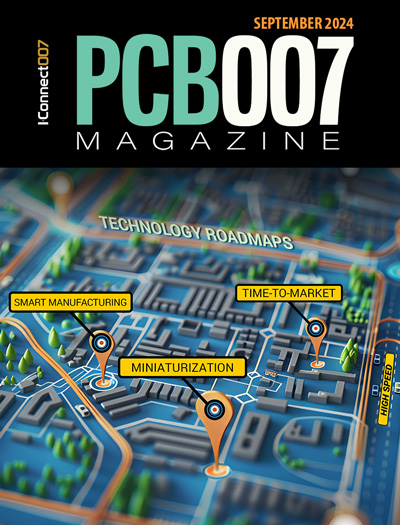-

- News
- Books
Featured Books
- pcb007 Magazine
Latest Issues
Current Issue
Engineering Economics
The real cost to manufacture a PCB encompasses everything that goes into making the product: the materials and other value-added supplies, machine and personnel costs, and most importantly, your quality. A hard look at real costs seems wholly appropriate.

Alternate Metallization Processes
Traditional electroless copper and electroless copper immersion gold have been primary PCB plating methods for decades. But alternative plating metals and processes have been introduced over the past few years as miniaturization and advanced packaging continue to develop.

Technology Roadmaps
In this issue of PCB007 Magazine, we discuss technology roadmaps and what they mean for our businesses, providing context to the all-important question: What is my company’s technology roadmap?
- Articles
- Columns
Search Console
- Links
- Media kit
||| MENU - pcb007 Magazine
Ventec Invests in Key Equipment to Support Expansion of PTFE Laminates Manufacturing
December 16, 2019 | Ventec International GroupEstimated reading time: 2 minutes
Ventec International Group Co., Ltd. has significantly increased its PTFE laminate manufacturing capabilities following a strategic investment in a new state-of-the-art high-temperature press and lay-up/break-down line at its Suzhou (China) manufacturing plant.
With 5G and evermore sophisticated radar applications, the demand and requirements for low loss/high frequency material is accelerating. Critical RF/Microwave-, antenna-, power amplifier- and sub-assembly-applications require superior electrical performance that can be delivered through PTFE laminates. To serve the increasing demand of these PTFE type products, Ventec has strengthened its investment in its Suzhou manufacturing plant to be even better positioned for the increase in demand and meet customers accelerated radar and 5G deployment requirements.
The most recent important equipment investment in a new state-of-the-art high-temperature press and lay-up/break-down line at Ventec’s Suzhou (China) manufacturing plant delivers a significant increase in manufacturing capacity to meet the growing demand for PTFE laminates. This includes the launch and roll-out of tec-speed 30.0 - Ventec’s latest ceramic filled high-speed/high-frequency PTFE material range that offers the highest signal-integrity characteristics for the most advanced high-frequency systems such as 77~79 GHz automotive radar systems.
tec-speed 30.0 (VT-3703) offers:
- Dk 3.0 with extremely low Df (0.0009)
- DK-stability versus temperature
- Lower in-plane thermal expansion
The current Dk 3.0 tec-speed 30.0 version will be supplemented by Dk 6.15 and Dk 10.2 versions in the first half of 2020, offering an even wider range of options for applications such as automotive radar, cellular base stations, power amplifiers & antennas, global positioning satellite antennas, patch antennas for wireless communication or power backplanes.
Jason Chung, CEO said: "The investment and installation of the PTFE manufacturing line is yet another important piece of the puzzle in our global growth program. The addition of the line to our range of capabilities demonstrates to our customers our commitment to maintaining the most up-to-date manufacturing technologies that support our clients’ PCB design, development and manufacturing needs."
For more information about Ventec's solutions and the company’s wide variety of products, please visit www.venteclaminates.com.
About Ventec International Group
Ventec International Group Co., Ltd. (6672 TT) is a premier supplier to the Global PCB industry. With volume manufacturing facilities in Taiwan and China and distribution locations and manufacturing sites in both the US and Europe, Ventec specializes in advanced copper clad glass reinforced and metal backed substrates. Ventec materials, which include high-quality enhanced FR4, high-speed/low-loss- & high-performance IMS material technology and an advanced range of thermal management solutions, are manufactured by Ventec using strict quality-controlled processes that are certified to AS9100 Revision D, IATF 16949:2016 and ISO 9001:2015, and are backed by a fully controlled and managed global supply chain, sales- and technical support-network.
Suggested Items
Unlocking Advanced Circuitry Through Liquid Metal Ink
10/31/2024 | I-Connect007 Editorial TeamPCB UHDI technologist John Johnson of American Standard Circuits discusses the evolving landscape of electronics manufacturing and the critical role of innovation, specifically liquid metal ink technology, as an alternate process to traditional metallization in PCB fabrication to achieve ever finer features and tighter tolerances. The discussion highlights the benefits of reliability, efficiency, and yields as a tradeoff to any increased cost to run the process. As this technology becomes better understood and accepted, even sought out by customers and designers, John says there is a move toward mainstream incorporation.
Fresh PCB Concepts: The Critical Nature of Copper Thickness on PCBs
10/31/2024 | Team NCAB -- Column: Fresh PCB ConceptsPCBs are the backbone of modern electronics and the copper layers within these boards serve as the primary pathways for electrical signals. When designing and manufacturing PCBs, copper thickness is one of the most critical factors and significantly affects the board’s performance and durability. The IPC-6012F specification, the industry standard for the performance and qualification of rigid PCBs, sets clear guidelines on copper thickness to ensure reliability in different environments and applications.
Book Excerpt: The Printed Circuit Designer’s Guide to... DFM Essentials, Ch. 1
10/25/2024 | I-Connect007The guidelines offered in this book are based on both ASC recommendations and IPC standards with the understanding that some may require adjustment based on the material set, fabricator processes, and other design constraints. This chapter details high-frequency materials, copper foil types, metal core PCBs, and the benefits of embedded capacitance and resistor materials in multilayer PCBs.
The Cost-Benefit Analysis of Direct Metallization
10/21/2024 | Carmichael Gugliotti, MacDermid AlphaCarmichael Gugliotti of MacDermid Alpha discusses the innovative realm of direct metallization technology, its numerous applications, and significant advantages over traditional processes. Carmichael offers an in-depth look at how direct metallization, through developments such as Blackhole and Shadow, is revolutionizing PCB manufacturing by enhancing efficiency, sustainability, and cost-effectiveness. From its origins in the 1980s to its application in cutting-edge, high-density interconnects and its pivotal role in sustainability, this discussion sheds light on how direct metallization shapes the future of PCB manufacturing across various industries, including automotive, consumer electronics, and beyond.
Connect the Dots: Designing for Reality—Pattern Plating
10/16/2024 | Matt Stevenson -- Column: Connect the DotsIn the previous episode of I-Connect007’s On the Line with… podcast, we painted the picture of the outer layer imaging process. Now we are ready for pattern plating, where fabrication can get tricky. The board is now ready to receive the copper traces, pads, and other elements specified in the original CAD design. This article will lay out the pattern plating process and discuss constraints in the chemistries that must be properly managed to meet the customer's exacting manufacturing tolerances.


